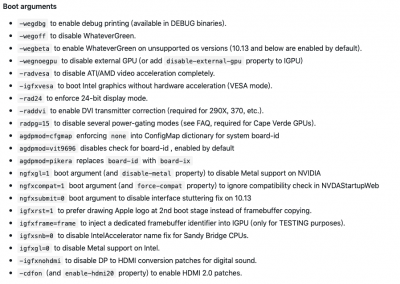- Joined
- May 14, 2017
- Messages
- 67
- Motherboard
- Lenovo G50-80
- CPU
- 5200U
- Graphics
- HD 5500, R5 330M(disabled)
- Mobile Phone
My Graphics Card is Intel HD Graphics HD5500. When I upgrade my system to Mojave, I got a DVMT kp and solved it like the first example in this guide with all KextsToPatch disabled:
https://www.tonymacx86.com/threads/guide-intel-framebuffer-patching-using-whatevergreen.256490/


But I found I cannot use HDMI Audio! So I Try to copy the KextsToPatch in whatevergreen like this the image below is also from the guide mentioned before)
the image below is also from the guide mentioned before)

But it doesn't work until I use Framebuffer-patch0-xxxx(I used Framebuffer-patch1-xxx at first) So I want to confirm a detail:
If I use whatevergreen KextsToPatch Function, Should I use the number of the patch name starting from 0 instead of 1? That is to say, The KextsToPatch in whatevergreen can only start with framebuffer-patch0-xxxx, and if you use framebuffer-patch1-xxx without Framebuffer-patch0-xxx, the Framebuffer-patch1-xxx wouldn't work.
Here is the Whatevergreen property I use now, and HDMI Audio really works. Please note that I disable the original KextsToPatch.

https://www.tonymacx86.com/threads/guide-intel-framebuffer-patching-using-whatevergreen.256490/


But I found I cannot use HDMI Audio! So I Try to copy the KextsToPatch in whatevergreen like this

But it doesn't work until I use Framebuffer-patch0-xxxx(I used Framebuffer-patch1-xxx at first) So I want to confirm a detail:
If I use whatevergreen KextsToPatch Function, Should I use the number of the patch name starting from 0 instead of 1? That is to say, The KextsToPatch in whatevergreen can only start with framebuffer-patch0-xxxx, and if you use framebuffer-patch1-xxx without Framebuffer-patch0-xxx, the Framebuffer-patch1-xxx wouldn't work.
Here is the Whatevergreen property I use now, and HDMI Audio really works. Please note that I disable the original KextsToPatch.

